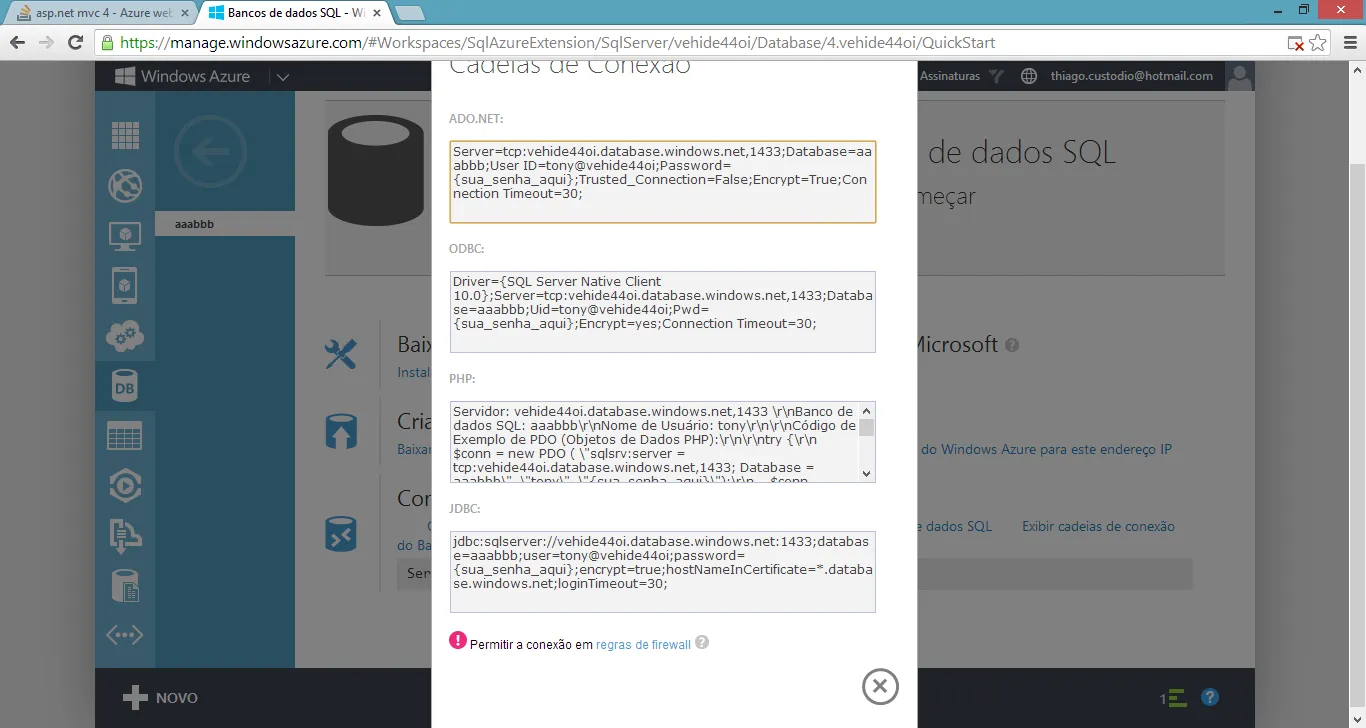我已经搜索了数小时,但找不到任何有用的信息。
使用ASP.NET MVC4和Windows Azure。
当我在我的开发计算机上本地运行站点时,使用SQL Azure连接字符串,我可以毫无问题地访问远程数据库。然而,当我部署该站点并尝试从[mysite].azurewebsites.com访问它时,在超时后出现以下错误(Azure中的连接字符串相同;复制并粘贴):
A network-related or instance-specific error occurred while establishing a connection to SQL
Server. The server was not found or was not accessible. Verify that the instance name is correct
and that SQL Server is configured to allow remote connections. (provider: SQL Network
Interfaces, error: 26 - Error Locating Server/Instance Specified)
Description: An unhandled exception occurred during the execution of the current web request.
Please review the stack trace for more information about the error and where it originated in
the code.
SQLExpress database file auto-creation error:
The connection string specifies a local Sql Server Express instance using a database location
within the application's App_Data directory. The provider attempted to automatically create the
application services database because the provider determined that the database does not exist.
The following configuration requirements are necessary to successfully check for existence of
the application services database and automatically create the application services database:
1.If the application is running on either Windows 7 or Windows Server 2008R2, special
configuration steps are necessary to enable automatic creation of the provider database.
Additional information is available at: http://go.microsoft.com/fwlink/?LinkId=160102. If the
application's App_Data directory does not already exist, the web server account must have read
and write access to the application's directory. This is necessary because the web server
account will automatically create the App_Data directory if it does not already exist.
2.If the application's App_Data directory already exists, the web server account only requires
read and write access to the application's App_Data directory. This is necessary because the web
server account will attempt to verify that the Sql Server Express database already exists within
the application's App_Data directory. Revoking read access on the App_Data directory from the
web server account will prevent the provider from correctly determining if the Sql Server
Express database already exists. This will cause an error when the provider attempts to create a
duplicate of an already existing database. Write access is required because the web server
account's credentials are used when creating the new database.
3.Sql Server Express must be installed on the machine.
4.The process identity for the web server account must have a local user profile. See the readme
document for details on how to create a local user profile for both machine and domain accounts.
Source Error:
An unhandled exception was generated during the execution of the current web request.
Information regarding the origin and location of the exception can be identified using the
exception stack trace below.
Stack Trace:
[SqlException (0x80131904): A network-related or instance-specific error occurred while
establishing a connection to SQL Server. The server was not found or was not accessible. Verify
that the instance name is correct and that SQL Server is configured to allow remote connections.
(provider: SQL Network Interfaces, error: 26 - Error Locating Server/Instance Specified)]
System.Data.SqlClient.SqlInternalConnection.OnError(SqlException exception, Boolean
breakConnection, Action`1 wrapCloseInAction) +5296071
System.Data.SqlClient.TdsParser.ThrowExceptionAndWarning(TdsParserStateObject stateObj, Boolean
callerHasConnectionLock, Boolean asyncClose) +558
System.Data.SqlClient.TdsParser.Connect(ServerInfo serverInfo, SqlInternalConnectionTds
connHandler, Boolean ignoreSniOpenTimeout, Int64 timerExpire, Boolean encrypt, Boolean
trustServerCert, Boolean integratedSecurity, Boolean withFailover) +5308555
System.Data.SqlClient.SqlInternalConnectionTds.AttemptOneLogin(ServerInfo serverInfo, String
newPassword, SecureString newSecurePassword, Boolean ignoreSniOpenTimeout, TimeoutTimer timeout,
Boolean withFailover) +145
System.Data.SqlClient.SqlInternalConnectionTds.LoginNoFailover(ServerInfo serverInfo, String
newPassword, SecureString newSecurePassword, Boolean redirectedUserInstance, SqlConnectionString
connectionOptions, SqlCredential credential, TimeoutTimer timeout) +920
System.Data.SqlClient.SqlInternalConnectionTds.OpenLoginEnlist(TimeoutTimer timeout,
SqlConnectionString connectionOptions, SqlCredential credential, String newPassword,
SecureString newSecurePassword, Boolean redirectedUserInstance) +307
System.Data.SqlClient.SqlInternalConnectionTds..ctor(DbConnectionPoolIdentity identity,
SqlConnectionString connectionOptions, SqlCredential credential, Object providerInfo, String
newPassword, SecureString newSecurePassword, Boolean redirectedUserInstance, SqlConnectionString
userConnectionOptions) +434
System.Data.SqlClient.SqlConnectionFactory.CreateConnection(DbConnectionOptions options,
DbConnectionPoolKey poolKey, Object poolGroupProviderInfo, DbConnectionPool pool, DbConnection
owningConnection, DbConnectionOptions userOptions) +5311099
System.Data.ProviderBase.DbConnectionFactory.CreateNonPooledConnection(DbConnection
owningConnection, DbConnectionPoolGroup poolGroup, DbConnectionOptions userOptions) +38
System.Data.ProviderBase.DbConnectionFactory.TryGetConnection(DbConnection owningConnection,
TaskCompletionSource`1 retry, DbConnectionOptions userOptions, DbConnectionInternal& connection)
+5313314
System.Data.ProviderBase.DbConnectionClosed.TryOpenConnection(DbConnection outerConnection,
DbConnectionFactory connectionFactory, TaskCompletionSource`1 retry, DbConnectionOptions
userOptions) +143
System.Data.SqlClient.SqlConnection.TryOpen(TaskCompletionSource`1 retry) +83
System.Data.SqlClient.SqlConnection.Open() +96
System.Web.Management.SqlServices.GetSqlConnection(String server, String user, String password,
Boolean trusted, String connectionString) +76
[HttpException (0x80004005): Unable to connect to SQL Server database.]
System.Web.Management.SqlServices.GetSqlConnection(String server, String user, String password,
Boolean trusted, String connectionString) +131
System.Web.Management.SqlServices.SetupApplicationServices(String server, String user, String
password, Boolean trusted, String connectionString, String database, String dbFileName,
SqlFeatures features, Boolean install) +89
System.Web.Management.SqlServices.Install(String database, String dbFileName, String
connectionString) +27
System.Web.DataAccess.SqlConnectionHelper.CreateMdfFile(String fullFileName, String dataDir,
String connectionString) +386
我尝试使用FTP查看远程web.config文件,但每次我尝试“设置部署凭据”时都会出现以下错误:
Failed to Set Credentials with error: 'Publishing username is already used. Specify a different publishing username.'
这种说法是胡扯的,因为根本没有设置“部署/FTP用户”。如果您能提供帮助,将不胜感激。

